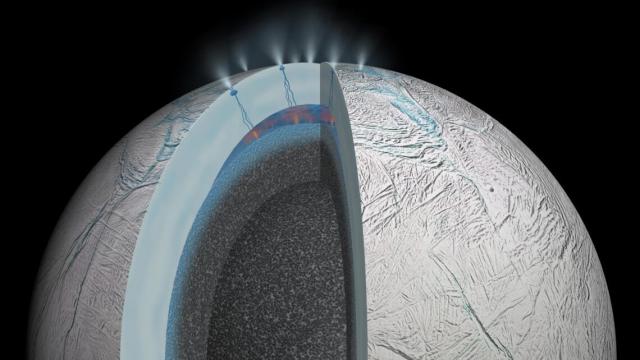Icy moons like Europa and Enceladus are exciting venues for the prospect of life beyond Earth, because they are thought to contain oceans of water beneath their frigid surfaces.
Now, a team of scientists has concluded that a single grain of material spewed up by the outgassing moons could contain biosignatures—signs of life—if there are any to detect. The team’s research was published today in Science Advances.
“For the first time we have shown that even a tiny fraction of cellular material could be identified by a mass spectrometer onboard a spacecraft,” said Fabian Klenner, a planetary scientist at the University of Washington and the study’s lead author, in a university release. “Our results give us more confidence that using upcoming instruments, we will be able to detect lifeforms similar to those on Earth, which we increasingly believe could be present on ocean-bearing moons.”
The team developed an experimental setup to simulate grains of ice in space, using the single-celled bacterium S. alaskensis as a proxy for theoretical astrobiology. The bacterium is very small, inhabits the frigid waters off Alaska, and doesn’t need much nutrition, making it an adequate stand-in for any life that may exist in the subsurface alien oceans. The researchers put liquid water containing S. alaskensis in a vacuum, and used a laser and spectral analysis to see whether the cellular material was detectable. Indeed, the bacterium—and in some cases, just portions of it—were detectable in the material, boosting hopes that the same techniques could be applied to real otherworldly material.
There are a couple of icy moon-bound missions on the horizon: NASA’s Europa Clipper, and ESA’s JUICE mission to the Jovian moons Ganymede, Callisto, and Europa. NASA’s Juno mission is already in the orbit of Jupiter, and will explore the planet’s moons in an extended mission.
Earlier this week, a different team of planetary scientists determined that the ice shell on Europa is at least 12.43 miles (20 kilometers) thick. That doesn’t grok with previous estimates of the moon’s ice, which suggested a thin layer covering a thick ocean.
“Understanding the thickness of the ice is vital to theorizing about possible life on Europa,” said Brandon Johnson, a planetary scientist at Purdue University and co-author of that paper, in a university release. “How thick the ice shell is controls what kind of processes are happening within it, and that is really important for understanding the exchange of material between the surface and the ocean. That is what will help us understand how all kinds of processes happen on Europa — and help us understand the possibility of life.”
Last year, a team studying data from the decommissioned Cassini spacecraft found that plumes of ice and water spewed up by Saturn’s moon Enceladus contained phosphorus, a key ingredient for life as we know it. These plumes of material can be massive. Also last year, the Webb Space Telescope saw a plume from Enceladus that was 20 times longer than the width of the moon itself. In a sense, these plumes bring the buried alien oceans to us, instead of space agencies needing to develop a means of boring through the ice.
Europa Clipper will carry an instrument called the SUrface Dust Analyzer (SUDA), which should be able to detect cellular material in just one ice grain out of hundreds of thousands spewed up in one of the moon’s water plumes.
The authors of the new paper hypothesize that bacterial cells in lipid membranes may rise to the ocean’s surface, forming a scum similar to seafoam on Earth. At cracks in the icy moons’ surfaces where the ocean is expelled in icy plumes, any bacteria-like astrobiological material could get pushed into space as well.
“It might be easier than we thought to find life, or traces of it, on icy moons,” said senior author Frank Postberg, a planetary scientist at the Freie Universität Berlin, in the University of Washington release.
The Europa Clipper will arrive in Jupiter’s orbit in April 2030, and JUICE will arrive at Jupiter in July 2031. We still have time to kill, but these new experiments are making these upcoming missions an even more exciting prospect.
